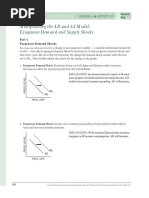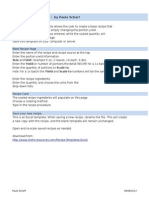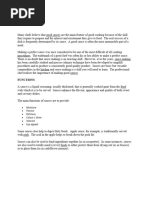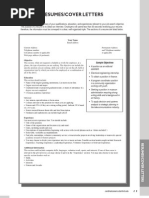Yield Management
Yield Management
Uploaded by
Dilip BrothersCopyright:
Available Formats
Yield Management
Yield Management
Uploaded by
Dilip BrothersOriginal Title
Copyright
Available Formats
Share this document
Did you find this document useful?
Is this content inappropriate?
Copyright:
Available Formats
Yield Management
Yield Management
Uploaded by
Dilip BrothersCopyright:
Available Formats
________________________________________________________________________
Advanced Food Production Management
YIELD MANAGEMENT
Yield is defined as the edible usable part of a food item / raw material, which is available
after preparation / pre preparation and cooking.
A standard yield is the yield obtained when an item is processed as per the particular standard
methods of preparation, cooking and portioning of an establishment.
The term yield means the net weight or volume of a food item after it has been processed and
made ready for sale to the guest. The difference between the raw or As purchased (AP) weight
and the prepared or Edible portion (EP) weight is termed as production loss. For example, if a
2.5kg fillet of beef is purchased and, after trimming and braising, 2 kg remain, there is a
production loss of 500 gm.
The amount of a product that remains after the processing performed as required, with in an
establishment is called the yield or yield%. Yield varies with each type of food. Yields may also
vary from establishment to establishment and even within an establishment from dept to dept.
With each type of product, such as produce or meats, the method of purchasing the product (its
market forms) and the degree of processing that has been performed on the product prior to
delivery, the yield may vary. A buyer for an establishment may have the option of purchasing
the item in several different forms, each having a different yield. In some cases the establishment
may choose to buy a certain items partially or fully prepared or cooked. Although the cost of the
food may be of primary interest to the establishment, the cost of labor, equipment, energy and
the quality of the final product must all be considered in the final analysis before making a
decision.
The chef’s role is to prevent wastage as much and obtain a net portion or a yield of a commodity
after processing. The yield is very important specially for expensive items like imported
vegetables, seafood and meats.
OBJECTIVES
________________________________________________________________________________________________________________________
Advanced Food Production Management
Page 1 of 10
________________________________________________________________________
To establish a standard for the quantity and number of portions obtainable from a specific
item of food.
To establish a standard for comparison with operating results and thereby measure the
efficiency of the production departments.
To establish an objective method of further evaluating standard purchasing specifications.
To establish a standard cost factor for the item of food.
To assist in menu costing and pricing.
To assist in converting forecast requirements into raw material requirements.
IMPORTANCE OF YIELD
Yield testing and yield factors are important for ant establishment for the following functions:
1. To determine product pricing.
2. To set purchase specifications and receiving standards.
3. To forecast purchase quantity and ordering levels.
4. Establishing standard recipes and portion size.
5. For setting control standards.
6. Comparison of vendor prices and quality.
7. Monitoring the usage of raw materials.
In general, there are three steps in the production process. The first is pre preparation, which
includes processes like trimming of meat, filleting of fish, peeling of vegetables. The second step
is preparation (or cooking). The third step is holding and could include portioning (including
carving a large joint of meat). A loss can occur in any one of these steps.
Previously, the chef or the establishment used to buy an entire carcass of an animal then butcher
it into the various cuts of meat needed. In some cases this method was inefficient, if the
establishment was unable to fully unitize all the cuts available from a carcass or additional
supplies of certain cuts were required due to demands and preferences of its customers. Here
with changing technology and improved methods of marketing this system has almost
________________________________________________________________________________________________________________________
Advanced Food Production Management
Page 2 of 10
________________________________________________________________________
completely vanished from the food service industry. Now the establishments need only purchase
those items that its customers prefer.
Meats are purchased in varying forms since any given establishment may differ in the method in
which it serves the product or even in the method in which it prepares the product. The
establishment has to determine which method of purchasing a product will be the most cost
effective or economical, presuming the end product will be of the same quality.
YIELD PERCENTAGE / FACTOR:
Yield percentage or yield factor is defined as the percentage of the whole purchase unit of an
item that is available for portioning after any required processing has been completed.
This percentage or factor is calculated by dividing the portionable weight by original weight of
the item before processing.
Remaining weight x 100 = Yield %
Original weight (AP)
Number of portions x unit portion size x 100 = Yield %
Purchase quantity
YIELD TEST
A yield test is performed on each item with respect to the product that needs to be made from
that item. For example – a yield test may be done for pineapples for pineapple juice and for
slices separately.
Yield testing is a very time consuming but an important process as it helps the establishment to
set its own standard yields for each of the item purchased. This helps to decide whom to
purchase from, determine accurately what output each item gives and set standards for purchase
for each item.
Yield testing is defined as a technique to determine the number of portions produced after
the required processing has been performed. These processes may include trimming,
butchering, cutting, cooking or some combination of these. During these processes fat, bone and
________________________________________________________________________________________________________________________
Advanced Food Production Management
Page 3 of 10
________________________________________________________________________
other inedible or unnecessary parts are removed. Also in some cases (roasts, for example) fat is
removed by melting during cooking process.
All these processes result in weight loss and thus the quantity available for portioning / serving
weighs less than the quantity originally purchased.
For effective yield testing, it is important to weigh the item after each set of process is
completed. The two important parts of yield testing are –
BUTCHER’S TEST
The butcher’s test, as the name states is mainly done for meats, fish and poultry purchased as
wholesale cuts.
It is used to determine the standard yield and portion cost for those items portioned before
cooking. Also the butcher test is done to establish the rational value for primary part of the
wholesale piece.
For example, if a particular cut of beef is approx. half fat and usable meat, the two parts have
clearly different uses and values even though they were purchased at the same price. Only on
conducting the butchers test the real value of the usable part is known.
Process of butcher’s test
Butcher’s test is conducted under the supervision of the chef and food controller.
The butcher will cut the item down into respective parts and start to process them as per the
standard portion sizes. All the parts, usable and non-usable are weighed and noted.
The total weight of all parts must be approx. equal to the weight of the whole. The difference if
any is noted down as a loss in cutting.
Thus, the yield or standard portion size available from an item after butchering is determined.
Butcher’s test must be conducted regularly on a reasonable no. of pieces so as to get a more
accurate yield of each item depending on what it is going to be used for. Generally, it is better to
have test results on a number of different pieces in order to arrive at averages.
________________________________________________________________________________________________________________________
Advanced Food Production Management
Page 4 of 10
________________________________________________________________________
Butcher’s test is also conducted to monitor the extent to which any one dealer is adhering to
specifications. With the help of butcher’s test results, menu prices can be planned because costs
are known.
The butcher’s test is also valuable to compare the cost of a pre portioned item purchased from
the vendor as against the cost of the same item processed in the establishment (keeping in
account the labor cost).
COOKING LOSS TEST
No yield testing is complete without determining the weight of the item that is available for
serving or otherwise called the salable weight.
Many items are portioned after cooking. Also there is a considerable amount of weight loss
during cooking in terms of loss of moisture and fat.
Thus the primary purpose of cooking loss test is to determine the standard final yield and thus
determine the standard portion size and cost.
When conducting the cooking loss test, it is important to note down the weight of the item
available before cooking, i.e., after all the trimming, cutting and removing of fat (if any). Then
the item is cooked as per the standard procedure and the weight of the item is noted down. If the
standard recipe requires the bone and cooked fat to be removed then the item is again weighed
after final portioning is done and this is recorded as salable weight. This salable weight is also
called the final yield or the portion size / weight of the item.
The final yield factor is obtained by dividing this weight by the original total weight of the item
purchased.
These ratios obtained during the process of yield testing helps to determine which of the several
available grades of commodities would yield maximum salable weight of the desired quality.
Also, cooking loss tests may be used to compare the results of cooking several pieces at different
temperature or for different lengths of time or in different methods so as to maximize the yield
keeping the quality standards in consideration.
________________________________________________________________________________________________________________________
Advanced Food Production Management
Page 5 of 10
________________________________________________________________________
Once the weight and the value of the salable portion is known, the standard portion size, the
prize and the cost can be determine and the standard can be established.
The types of test those are necessary in meat products are:
1. Trim Test: A trim test determines the amount of the excess fat or unusable meat that has
been left on the carcass or joint or product by a supplier.
Fully trimmed joint x 100 = Trimming yield%
Untrimmed joint
The degree or thickness of interior and exterior fat that cannot be used in serving will
naturally reduce the amount of the usable edible portion that can be served. (A maximum of
½ inch of exterior fat is recommended for roasts and ¼ inch for steaks, chops etc.)
2. Boning Yield Test: A product may be partially or fully deboned. To accurately compare
products the end product must be exactly equal in the length or amount of bone with some
items. The weight of the remaining bone may also have to be determined at some future stage
of processing.
Boneless weight X 100 = Boning yield %
Bone in weight
The yield grades for beef as established by the government in abroad normally result in a
yield of 52.4% or more for a carcass that has been graded yield 1, down to a yield of 45% or less
those carcasses graded yield 5 . These figures are based on the live carcass weight of the animal.
Useable cuts of meat x 100 divided by Live carcass weight = yield%
Actual Cost: Price per pound or Kg of the carcass divided by yield % will give the actual cost
per pound or Kg.
Normally food service establishments do not buy whole carcasses, so it is necessary to establish
yield % of the primal cuts that may be purchased. This can be calculated by
Useable meat x 100 divided by Primal cut weight = Yield %.
Pork, beef and lamb all have yield grades that may be used to determine the most economical
method of buying.
________________________________________________________________________________________________________________________
Advanced Food Production Management
Page 6 of 10
________________________________________________________________________
3. Cooking Yield: All meats will shrink to some extent during the cooking process due to loss
moisture and the melting of fat. The amount of shrinkage depends to a great extent upon the
final temperature of the cooked product, as well as on the temperature at which the product
was cooked. The method of cooking may also affect shrinkage, since moist heat cookery may
result in less moisture being lost from the product. It is generally recommended that meats be
cooked at low temperatures (300 to 375F) as this type of cookery results in less shrinkage
from both the loss of moisture and the loss of fat.
Weight after cooking x 100 = Cooking yield %
Weight prior to cooking
4. Serving yield: In finer establishments, only lean slices are used for service. In lower priced
operations ends, shreds, and even unappetizing looking pieces may also be served. The actual
number of portions that can be served from a roast multiplied by the portion size determines
the net serving weight.
Serving weight x 100 = Serving yield %
Original weight prior to serving
Poultry when purchased in varying weights will differ in yields. The small birds generally have a
lower yield in edible meat. Large birds may yield less, in that there may be an over development
of bone structure and excessive fat in proportion to lean meat.
Fish and seafood have yield price tags comparable to those of meat and poultry.
A standard yield results when an item is produced according to established standard production
procedures outlined in the standard recipe. It serves as the base against which to compare actual
yields. For example, if the standard purchase specifications are adhered to, and a meat item is
properly trimmed, cooked and portioned, the actual yield should be closely approximate to the
standard yield.
DETERMINING STANDARD YIELD
Standard yields are determined by conducting a yield test. Ideally, everything that does not have
a 100% yield should be tested. Yield testing could also be carried out to find out trimming losses
________________________________________________________________________________________________________________________
Advanced Food Production Management
Page 7 of 10
________________________________________________________________________
especially for vegetables. Normally, yield tests are carried out on high cost products and low cost
products that are used in large volumes (potatoes)
The yield from a product depends on several factors, including the grade, original weight and pre
preparation and cooking methods. Therefore it is advisable to compare products and yields from
different suppliers. The yield test is often referred to a Butchers Test as this was originally
applied to meat produce.
COST PER SERVABLE KG
After trimming and cooking loss is calculated and the edible (servable) portion weight is
determined, a cost per servable KG (or gm or pound) can be determined. To find the cost per
servable KG, first establish the yield percentage. The yield percentage is also called the yield
factor. This is the ratio of servable to original weight.
Servable weight
-------------------- x 100 = yield %
Original weight
The cost per servable KG is found by dividing the AP price by the yield %
AP Price
------------------ = cost per servable KG
Yield %
The cost per servable Kg is the information needed to calculate standard portion costs.
One can make a similar calculation to determine the total AP quantity needed once the yield % is
known.
Quantity needed x edible portion
--------------------------------------- = quantity to purchase/prepare
Yield %
________________________________________________________________________________________________________________________
Advanced Food Production Management
Page 8 of 10
________________________________________________________________________
THE COST FACTOR
The cost factor is a constant value that may be used to convert new AP price into a revised cost
when purchase prices change. The cost factor assumes that purchase specifications, recipes and
yield remain the same.
Cost per servable KG
----------------------------- = cost factor
AP Price
A portion cost can also be calculated after calculating yield.
Cost of all ingredients in a recipe
----------------------------- = Portion cost
Number of portions
Hence the food cost percentage would be:
Portion cost of the dish
----------------------------------- x 100 = Food cost %
Selling price of the dish
Normally food service establishments follow a food cost of 20%-25% which determines good
quality of food is maintained. Some dishes may have a high food cost, some may have a low
food cost, what is to be taken care of is that the menu is balanced and an overall food cost of
25% is maintained.
The selling price of the dish depends on this food cost and other expenses and profit. Staff should
be trained well to attain this profit by maintaining food cost. They should be aware of the cost
and yields to know the cost of production.
ADJUSTING STANDARD RECIPE YIELDS
The yield from a standard recipe can easily be increased or decreased by using an adjustment
factor. This is found by dividing the desired yield by the original yield. For example, if a recipe
yields 100 portions and you want 225 portions of the same size the adjustment factor would be
________________________________________________________________________________________________________________________
Advanced Food Production Management
Page 9 of 10
________________________________________________________________________
Desired yield 225 portions
--------------- = adjustment factor --------------- = 2.25
Original yield 100 portions
Using the adjustment factor/conversion factor can provide very accurate ingredient quantities
when the total volume of a recipe’s yield does not change significantly. However, the use of the
adjustment factor for a recipe in which the yield changes substantially must be done carefully. It
is unlikely that a recipe yielding 10 portions of a specific size can be merely multiplied by the
adjustment factor of 100 to yield 1000 portions of the same size. In such cases, it is best to start
with the adjustment factor and then modify it carefully until the recipe yields the desired volume.
Yield is defined as the edible usable part of a food item / raw material, which is available after
preparation / pre preparation and cooking.
A standard yield is the yield obtained when an item is processed as per the particular standard
methods of preparation, cooking and portioning of an establishment.
FACTORS THAT ARE INVOLVED IN YIELD TESTING
PURCHASE The weight of the raw material as purchased to a known standard and as per
WEIGHT specifications
That weight of the item that is available for cooking or further processing after all
USABLE WEIGHT the unusable and inedible parts are removed. Mainly applies to meat, fish, and
poultry and in some cases to fruits and vegetables
COOKED WEIGHT Weight of the item after it has been cooked as per standard procedure
SALEABLE
The unit weight / quantity which is served
WEIGHT
∞∞∞∞∞∞∞∞
________________________________________________________________________________________________________________________
Advanced Food Production Management
Page 10 of 10
You might also like
- Bar OperationsDocument8 pagesBar OperationsDilip Brothers100% (3)
- Global Real Estate Transparency Index 2012 - WWW - Metrecarre.maDocument44 pagesGlobal Real Estate Transparency Index 2012 - WWW - Metrecarre.mametrecarreNo ratings yet
- As and Ad Answer Key PDFDocument5 pagesAs and Ad Answer Key PDFkru1206No ratings yet
- Main DishDocument15 pagesMain DishRichelle ReyesNo ratings yet
- Culinary Math FormulasDocument1 pageCulinary Math FormulasAn Ling100% (1)
- Dynamic Recipe Scaler - by Paula Scharf: Size and Unit: Example 5 Oz, 2 Loaves, 10 Each, 3 DozDocument5 pagesDynamic Recipe Scaler - by Paula Scharf: Size and Unit: Example 5 Oz, 2 Loaves, 10 Each, 3 DozNishana ShajahanNo ratings yet
- PASTA Worksheet Completed QDocument12 pagesPASTA Worksheet Completed QgufeoNo ratings yet
- History of Culinary Arts: Raquel Q. MontañoDocument10 pagesHistory of Culinary Arts: Raquel Q. MontañoKristine May Ducusin100% (1)
- Ujjain CDP - FinalDocument408 pagesUjjain CDP - FinalRaghav GuptaNo ratings yet
- Manufacturing - Greater Dublin AreaDocument2 pagesManufacturing - Greater Dublin AreaDylanOSullivanNo ratings yet
- LCCM Research Digest (November-December 2007 Ed.)Document4 pagesLCCM Research Digest (November-December 2007 Ed.)mis_administratorNo ratings yet
- Culinary Terminology - Assigment 1Document2 pagesCulinary Terminology - Assigment 1Gary Roach100% (1)
- Quiz 3 - Introduction To Modern Food ServiceDocument41 pagesQuiz 3 - Introduction To Modern Food ServiceHany Dyanne Andica TeopeNo ratings yet
- Provide Gueridon Service RefinedDocument190 pagesProvide Gueridon Service RefinedGwyne PosadasNo ratings yet
- SQPMS Food Production IVDocument8 pagesSQPMS Food Production IVSachinJosephNo ratings yet
- Sanitation in The KitchenDocument3 pagesSanitation in The KitchenShielaMaeTorinoPilisingNo ratings yet
- Lesson 7 On Aspic, Chaudfroid, ColeesDocument10 pagesLesson 7 On Aspic, Chaudfroid, ColeesBonophool Banerjee100% (1)
- Food Plating Tips For Plating Your FoodDocument15 pagesFood Plating Tips For Plating Your FoodRaphael samboNo ratings yet
- Peppers: The Right Ingredients For Your CareerDocument1 pagePeppers: The Right Ingredients For Your CareerIaraCoutoNo ratings yet
- TrainingmaterialsDocument14 pagesTrainingmaterialsAashiesh Bhalla100% (1)
- Grocery List by FitmencookDocument2 pagesGrocery List by FitmencookSantiago GomezNo ratings yet
- Handle and Serve CheeseDocument23 pagesHandle and Serve CheeseNickela McMahonNo ratings yet
- HT2 CoCU 6 Appetizer ProductionDocument9 pagesHT2 CoCU 6 Appetizer ProductionMatt MattNo ratings yet
- SAG - Food Production (Professional Cookery) NC III (COC 2)Document5 pagesSAG - Food Production (Professional Cookery) NC III (COC 2)Cha eun WooNo ratings yet
- Blue-Book For InspectionsDocument28 pagesBlue-Book For InspectionsAriel AlmandozNo ratings yet
- Basic Mother Sauce and GlossaryDocument10 pagesBasic Mother Sauce and GlossarymangunjongNo ratings yet
- Chapter10 ForcemeatDocument9 pagesChapter10 ForcemeatManikandan RajuNo ratings yet
- The SaucesDocument13 pagesThe SaucesPratik ShakyaNo ratings yet
- Breakfast Launch DilemmaDocument13 pagesBreakfast Launch Dilemmanew_draks100% (1)
- Kitchen Tools and EquipmentDocument136 pagesKitchen Tools and EquipmentBianca Margarette CabelNo ratings yet
- Day 1 (Houserules)Document174 pagesDay 1 (Houserules)natoalvarez.appleNo ratings yet
- Busboy ServicingDocument17 pagesBusboy ServicingMjhayNo ratings yet
- Basic Knife CutsDocument30 pagesBasic Knife CutsCecilleMananitaNo ratings yet
- Ch03 CostControl FinalDocument22 pagesCh03 CostControl FinalAntonette HernandezNo ratings yet
- Part 1 The BasicDocument41 pagesPart 1 The BasicAlip SurotoNo ratings yet
- Food PlatingDocument6 pagesFood PlatingYvonne Angel MedranoNo ratings yet
- Types and Categories of MenusDocument18 pagesTypes and Categories of MenusKrizza Nica ParumNo ratings yet
- pg12238 Images kf8Document1,030 pagespg12238 Images kf8Hydraulic Press videoNo ratings yet
- Food Trial Sous Chef AshishDocument1 pageFood Trial Sous Chef AshishashishthapsterNo ratings yet
- What Is CookingDocument9 pagesWhat Is CookingponavnitNo ratings yet
- TM Prepare Portion Controlled Meat Cuts FN 230114Document70 pagesTM Prepare Portion Controlled Meat Cuts FN 230114Richard ZawNo ratings yet
- 17 Course French Classical MenuDocument8 pages17 Course French Classical Menupghr24ispitabNo ratings yet
- Cuts of VegetablesDocument19 pagesCuts of Vegetableschefsden.2211No ratings yet
- American CulinaryDocument12 pagesAmerican CulinaryNancy AgustiniNo ratings yet
- 11 Course French Classical MenuDocument34 pages11 Course French Classical MenuYash RaghavNo ratings yet
- Food Additives PDFDocument12 pagesFood Additives PDFHerianka DefriNo ratings yet
- 4th CookeryDocument7 pages4th CookeryMeach CallejoNo ratings yet
- French CuisineDocument22 pagesFrench Cuisinesonam2411No ratings yet
- Catering Menu ProgramDocument51 pagesCatering Menu ProgramLi An BautistaNo ratings yet
- Iron Stone Final MenuDocument8 pagesIron Stone Final Menunewshound373No ratings yet
- Recipe Costing Form: M N - P Q #3 D - A T QDocument8 pagesRecipe Costing Form: M N - P Q #3 D - A T QKiran GadmaleNo ratings yet
- Food Production Operation by Souren ChoudhuryDocument113 pagesFood Production Operation by Souren ChoudhuryAnonymous wTlfoxCDhNo ratings yet
- Measuring and CookingDocument28 pagesMeasuring and CookingJames100% (1)
- Kitchen Manual: Featuring Organic, Locally Grown Food Made With LoveDocument29 pagesKitchen Manual: Featuring Organic, Locally Grown Food Made With LoveIonut StoicaNo ratings yet
- 2 Principles of Food ProductionDocument40 pages2 Principles of Food ProductionRubyann Faye Obero LendioNo ratings yet
- Training AssignmentDocument5 pagesTraining AssignmentAjith NAIRNo ratings yet
- Products and PreservationDocument28 pagesProducts and PreservationFilmar AndradaNo ratings yet
- Darbyv FoodethicperosnalessayDocument2 pagesDarbyv Foodethicperosnalessayapi-386197214No ratings yet
- Sales and Income Projections - Crispy FlakeyDocument11 pagesSales and Income Projections - Crispy FlakeyManuel FailanoNo ratings yet
- Bakers PercentagesDocument4 pagesBakers PercentagesmadbakingNo ratings yet
- Waste into Taste: Turning Scraps into Delicious DishesFrom EverandWaste into Taste: Turning Scraps into Delicious DishesNo ratings yet
- Chapter 11 - Project Management-2Document24 pagesChapter 11 - Project Management-2Dilip BrothersNo ratings yet
- Note IhmDocument30 pagesNote IhmDilip BrothersNo ratings yet
- 07 - Chapter 1 PDFDocument24 pages07 - Chapter 1 PDFDilip BrothersNo ratings yet
- Pranjal DayalDocument79 pagesPranjal DayalDilip BrothersNo ratings yet
- Budgeting: Types of Budgets & Budget CycleDocument7 pagesBudgeting: Types of Budgets & Budget CycleDilip BrothersNo ratings yet
- Bege 103 PDFDocument13 pagesBege 103 PDFDilip BrothersNo ratings yet
- Buddhism 2017 PDFDocument12 pagesBuddhism 2017 PDFDilip BrothersNo ratings yet
- User'S Manual: Indoor Unit Outdoor UnitDocument28 pagesUser'S Manual: Indoor Unit Outdoor UnitJesule Gallardo SanzNo ratings yet
- MG 405 Money and Banking 61015924 2Document2 pagesMG 405 Money and Banking 61015924 2Akshika AzadNo ratings yet
- ACTG 243 Decision Making With Accounting Information Final Exam 01Document3 pagesACTG 243 Decision Making With Accounting Information Final Exam 01Đinh Ngọc Minh ChâuNo ratings yet
- 30814-107006-2-PB IndoDocument9 pages30814-107006-2-PB IndoZidan Miftahul MubarokNo ratings yet
- Go Air LetterDocument3 pagesGo Air LettersriNo ratings yet
- World Trade Organization and IPRDocument5 pagesWorld Trade Organization and IPRKunal KolheNo ratings yet
- Enterprise Creation and Entrepreneurshp Revision PaperDocument94 pagesEnterprise Creation and Entrepreneurshp Revision Paperv5kbkrmdfpNo ratings yet
- Budget Booklet Ready Reckoner 2012 13Document62 pagesBudget Booklet Ready Reckoner 2012 13www.TdsTaxIndia.comNo ratings yet
- 08 Resumes Cover LetersDocument17 pages08 Resumes Cover LetersSreeprasad GovindankuttyNo ratings yet
- Nama Perusahaaan ProposalDocument14 pagesNama Perusahaaan ProposalTitaniaveronica SijabatNo ratings yet
- TOPIC 10 (Aggregate Expenditure Equilibrium Output)Document57 pagesTOPIC 10 (Aggregate Expenditure Equilibrium Output)刘伟康No ratings yet
- Yemane Berhe Concept Note For ECO Axum PDFDocument96 pagesYemane Berhe Concept Note For ECO Axum PDFabel_kayel100% (1)
- ACC432-Case Studies - Summer 2014Document8 pagesACC432-Case Studies - Summer 2014derkungNo ratings yet
- Annual Report 2011 12 EDocument267 pagesAnnual Report 2011 12 ERajeev Singh BhandariNo ratings yet
- CSEC Economics P1 BookletDocument162 pagesCSEC Economics P1 BookletHungrySamaNo ratings yet
- 005 15 1-2'' String Stabilzer Am-Pt-Sstb-15120013 (12-12-21) PmiDocument1 page005 15 1-2'' String Stabilzer Am-Pt-Sstb-15120013 (12-12-21) PmiAboozar FathinejadNo ratings yet
- Design Options For Transportation NetworkDocument14 pagesDesign Options For Transportation NetworkpinakNo ratings yet
- Media to Upload1682573248Document25 pagesMedia to Upload1682573248vikrambhats.associatesNo ratings yet
- Swot United Way of DelawareDocument14 pagesSwot United Way of Delawareapi-458502215No ratings yet
- List of Industries in Mechanical EngineeringDocument3 pagesList of Industries in Mechanical Engineeringडॉ. कनिष्क शर्माNo ratings yet
- East Kalimantan Power PlantsDocument5 pagesEast Kalimantan Power Plantswidyo saptotoNo ratings yet
- Tugas 2 Bahasa Inggris NiagaDocument2 pagesTugas 2 Bahasa Inggris NiagapurniaNo ratings yet
- Coal Vessel Updates As On 18 Mar 20Document15 pagesCoal Vessel Updates As On 18 Mar 20Frianata ZrNo ratings yet
- Sarvam VasudevamayamDocument64 pagesSarvam VasudevamayamSrinivas NarasimhadevaraNo ratings yet
- DNS BrochureDocument62 pagesDNS BrochureQUYEN TRANNo ratings yet

































































































